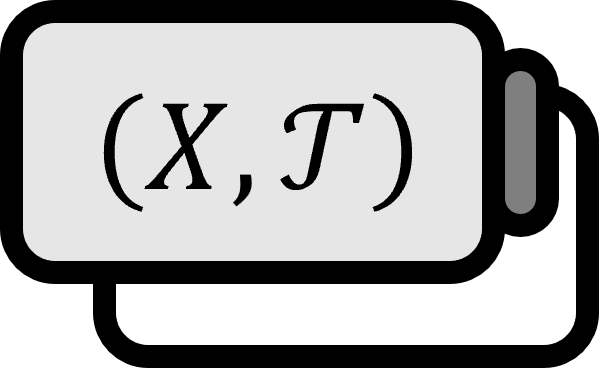Homomorphism Preserves Basis
Theorem
Let’s suppose two topological spaces $X$, $Y$ and a homeomorphism $f$ between them are given. $$ f\ :\ X \rightarrow Y $$ If $\mathcal{B}_{X}$ is called a basis of $X$, then $f(\mathcal{B}_{X})$ becomes a basis of $Y$.
Description
Simply put, a homeomorphic mapping preserves the basis.
Proof
A collection $\mathcal{B}$ of subsets of $X$ that satisfies the following two conditions is called a basis for the topology on $X$:
- $(b1)$: For any $x\in X$, there exists a $B \in \mathcal{B}$ satisfying $x \in B$. That is, $\bigcup \nolimits_{B\in\mathcal{B}} B=X$
- $(b2)$: For any $B_{1},B_2 \in \mathcal{B}$ and $x\in \big( B_{1} \cap B_2 \big)$, there exists a $B_{3} \in \mathcal{B}$ satisfying $x \in B_{3} \subset \big( B_{1} \cap B_2 \big)$.
It is necessary to check whether $f(\mathcal{B}_{X})$ satisfies these two conditions in $Y$.
$(b1)$
Let’s consider $\mathcal{B}_{X}=\left\{ B_{X}^1,\ B_{X}^2,\ \cdots \right\}$. We need to show that $\bigcup f(B_{X}^k)=Y$. Since $f$ is a homeomorphism, for any $y \in Y$, there exists a $f^{-1}(y)$. Then for each $y$, there exists a $B_{X}^k$ satisfying $f^{-1}(y) \in B_{X}^k$. Furthermore, since $f(\bigcup\nolimits_{i} A_{i})=\bigcup\nolimits_{i} f(A_{i})$1 $$ \bigcup f(B_{X}^k)=f( \bigcup B_{X}^k )=f(X)=Y $$
$(b2)$
Similarly, for any $y$, there exists a $f^{-1}(y)$. By the definition of a basis, for $f^{-1}(y) \in \big( B_{X}^1 \cap B_{X}^2 \big)$, there exists a $B_{X}^3$ satisfying the following condition: $$ f^{-1}(y) \in B_{X}^3 \subset \big( B_{X}^1 \cap B_{X}^2 \big) $$ Then $y \in f(B_{X}^3)$, and because $f$ is a bijection that preserves intersections2 $$ f(B_{X}^3) \subset f\big( B_{X}^1 \cap B_{X}^2 \big)=f(B_{X}^1)\cap f(B_{X}^2) $$ Therefore, there exists a $f(B_{X}^3)$ satisfying $y\in f(B_{X}^3)\subset \big( f(B_{X}^1) \cap f(B_{X}^2) \big)$. Thus, since $f(\mathcal{B}_{X})$ satisfies the conditions $(b1)$ and $(b2)$, it is a basis for $Y$.
■
